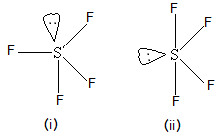
Which of the following shapes of \[S{F_4}\] is more stable and why?

(A) (i) Lone pair at axial position is stable
(B) (ii) Lone pair at equatorial position is stable
(C) Both are equally stable due to lp-lp repulsion
(D) Both are unstable since \[S{F_4}\] has tetrahedral shape
Answer
140.4k+ views
Hint: Repulsive forces between bond pairs and lone pairs have influence on the shapes of the molecules. Lone pair-lone pair repulsions are the most strong repulsions of these types of repulsions.
Complete step by step solution:
In both the shapes of \[S{F_4}\], we can say that the only difference is that lone pair is at axial position and in another shape, the lone pair of sulphur atoms is in equatorial position. So, let’s compare them two and their stability.
- In (i), lone pair is at axial position and hence, it has three fluorine atoms in the vicinity that give lone pair-bond pair repulsion. While in case of (ii), the lone pair of sulphur is having only two fluorine atoms in the vicinity and hence it will have two lone pair-bond pair repulsions with fluorine atoms.
- The rest of the repulsive factors are almost the same in both the molecules.
- So, based on this discussion, we can conclude that structure (ii) will be more stable because there is less repulsion for sulphur lone pair in comparison with structure (i).
Thus correct answer is (B) (ii) Lone pair at equatorial position is stable
Additional Information:
- If the atoms that are situated at a position that is in the plane that involves most number of atoms in that molecule, then the positions are called equatorial positions and axial positions are perpendicular to the equatorial ones.
Note: Do not consider that \[S{F_4}\] has a tetrahedral shape because it has 4 atoms binded with it, also take the lone pair of the central atom into consideration which also has higher repulsion towards other bond pairs. Do not consider that the amount of repulsion will be the same for all the compounds that have the same atoms; the arrangement of these atoms in space decides the repulsive factors.
Complete step by step solution:
In both the shapes of \[S{F_4}\], we can say that the only difference is that lone pair is at axial position and in another shape, the lone pair of sulphur atoms is in equatorial position. So, let’s compare them two and their stability.
- In (i), lone pair is at axial position and hence, it has three fluorine atoms in the vicinity that give lone pair-bond pair repulsion. While in case of (ii), the lone pair of sulphur is having only two fluorine atoms in the vicinity and hence it will have two lone pair-bond pair repulsions with fluorine atoms.
- The rest of the repulsive factors are almost the same in both the molecules.
- So, based on this discussion, we can conclude that structure (ii) will be more stable because there is less repulsion for sulphur lone pair in comparison with structure (i).
Thus correct answer is (B) (ii) Lone pair at equatorial position is stable
Additional Information:
- If the atoms that are situated at a position that is in the plane that involves most number of atoms in that molecule, then the positions are called equatorial positions and axial positions are perpendicular to the equatorial ones.
Note: Do not consider that \[S{F_4}\] has a tetrahedral shape because it has 4 atoms binded with it, also take the lone pair of the central atom into consideration which also has higher repulsion towards other bond pairs. Do not consider that the amount of repulsion will be the same for all the compounds that have the same atoms; the arrangement of these atoms in space decides the repulsive factors.
Recently Updated Pages
Types of Solutions - Solution in Chemistry

Difference Between Crystalline and Amorphous Solid

JEE Main Participating Colleges 2024 - A Complete List of Top Colleges

JEE Main Maths Paper Pattern 2025 – Marking, Sections & Tips

Sign up for JEE Main 2025 Live Classes - Vedantu

JEE Main 2025 Helpline Numbers - Center Contact, Phone Number, Address

Trending doubts
JEE Main 2025 Session 2: Application Form (Out), Exam Dates (Released), Eligibility, & More

JEE Main 2025: Derivation of Equation of Trajectory in Physics

JEE Main Exam Marking Scheme: Detailed Breakdown of Marks and Negative Marking

Learn About Angle Of Deviation In Prism: JEE Main Physics 2025

Number of sigma and pi bonds in C2 molecule isare A class 11 chemistry JEE_Main

Electric Field Due to Uniformly Charged Ring for JEE Main 2025 - Formula and Derivation

Other Pages
NCERT Solutions for Class 11 Chemistry Chapter 9 Hydrocarbons

NCERT Solutions for Class 11 Chemistry Chapter 7 Redox Reaction

JEE Advanced Marks vs Ranks 2025: Understanding Category-wise Qualifying Marks and Previous Year Cut-offs

NCERT Solutions for Class 11 Chemistry Chapter 5 Thermodynamics

Hydrocarbons Class 11 Notes: CBSE Chemistry Chapter 9

NCERT Solutions for Class 11 Chemistry In Hindi Chapter 1 Some Basic Concepts of Chemistry




